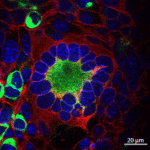Lien vers Pubmed [PMID] – 25722199
Clin. Infect. Dis. 2015 Jun;60(11):1667-76
BACKGROUND: HTLV-1 infection is endemic to Central African populations. The risk factors for HTLV-1 acquisition in humans via the interspecies transmission of STLV-1 (its simian counterpart) remain largely unknown.
METHODS: We studied 269 individuals (254 men, 15 women) bitten by a nonhuman primate (NHP), mostly during hunting activities. These, Pygmies and Bantus, living in the southern Cameroonian rainforest, were matched for sex, age, and ethnicity with individuals from the same settlements reporting no NHP bites. HTLV-1 serology was performed by Western blot on plasma samples. PCR was carried out for HTLV-1 provirus on buffy-coat DNAs. The amplified products were sequenced and analyzed by phylogenetic analyses.
RESULTS: HTLV-1 prevalence was 8.6% (23/269) in individuals with bites, vs 1.5% (4/269) in matched controls (P < .001). Moreover, HTLV-1 infection was linked to bite severity. The 23 HTLV-1-positive bitten individuals reported being bitten by a gorilla (17), chimpanzee (3), or small monkey (3). Thirteen (56%) were coinfected with a simian foamy virus known to be acquired through severe bites. Mother-to-child infection was excluded in 6 HTLV-1-infected bitten individuals. All the HTLV-1-positive hunters bitten by a gorilla or chimpanzee were infected with a subtype B strain similar to that present in apes from the same area. Two hunters bitten by small monkeys (C. agilis in one case) were infected with a HTLV-1 subtype F strain very similar to the STLV-1 strains present in such monkeys.
CONCLUSIONS: These results strongly suggest ongoing direct zoonotic acquisition of STLV-1 in humans through severe NHP bites during hunting activities.


